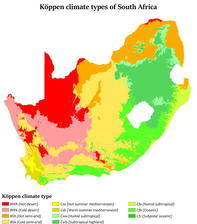
Climate and Rainfall in South Africa
South Africa is a hot, dry country, with the average annual precipitation over 65% of its surface area being less than 500 mm. This rainfall is considered as the bottom limit for successful rainfed crop production. Several crops have much higher rainfall requirements, such as tea plantations needing over 1 000 mm per year.
The seasonal nature of rainfall in South Africa necessitates irrigation even in farming areas with a high average annual rainfall. The deciduous fruit crops in Ceres in the Western Cape is an example. Crops are irrigated during the dry summers as this area only receives a high average annual rainfall in winter.
Because South Africa is such a hot, dry country the average annual water loss through evaporation is high and increases the need for irrigation water.
What is Macro-climate?
Macro-climate refers to climate on a national or country scale. Large areas with similar types of climates are grouped together and outlined on a map.
These can be classifications based on combinations of several climatic parameters such as the Köppen climate zones. The Köppen climate classification divides climates into five major types, represented by the capital letters A, B, C, D and E. For example A is tropical and E is polar.
What is Meso-climate?
Meso-climate refers to localised climate. Several types of meso-climates can be found within a specific macro-climate zone. The climatic characteristics of meso-climates and their geographic distribution are usually mainly determined by topography.
Topography includes features such as valleys, mountains and rivers. Meso-climates around the Magaliesberg, running east-west from Pretoria past Rustenburg provide an excellent example.
The middle slopes on the northern side of the mountain are much warmer than the middle slopes on the southern side. These are then two different meso-climates. The northern slopes are facing towards the sun and a certain bundle of sun rays covers a relatively narrow area, thus providing more heat per unit area.
The northern slopes of the Magaliesberg are frost-free and have year-round high temperatures suitable for citrus and subtropical crops under irrigation. The lower-lying foot slopes, however, have a completely different climate from the middle slopes. Here, winters are cold and frost makes this area unsuitable for subtropical crops.